This article discusses colorful blown glass produced predominantly at the New England Glass Company and the Mount Washington Glass Company (although also attempted by various other glass manufacturers) in the 19th century. It notes some of the most talented craftsmen and innovative colors of the time, and provides a step-by-step explanation of the process of creating colored glass, illustrating the differences in production compared with normal overlay glass. It originally appeared in the January 1940 issue of American Collector magazine, a publication which ran from 1933-1948 and served antique collectors and dealers.
American glass of the last quarter of the 19th Century means to many nothing but pattern glass. Yet during this same period tremendous advances in the art of blown glass were made by four or five men of genius working in the few factories where appreciation of the glassblower’s skill and creative ability still continued, and where it was realized that there was still an excellent market in America for delicately blown and colorful glass. Naturally, it was Victorian in design and spirit, but the fine craftsmanship and technique of achieving colors and gradations of tone in a single piece mark one of the high points in American glass.

Pitcher of Mother-of-Pearl Glass: In color, this piece is a brilliant pastel blue which is set off by the lattice of the exterior, the translucent handle, and the rim at the mouth.
Up to now scant regard has been given these pieces by collectors. In fact, they have been dismissed offhandedly as Victorian decorative pieces, with little consideration of the artist’s skill or of the houses at which they were made. Also, except for a few scattering comments, relatively little has been written about this special class of American glass. Therefore, any discussion of it must be based largely on a critical study of representative examples in the collection recently gathered by Mrs. John N. Bergstrom of Neenah, Wisconsin, which now forms a special loan exhibition at The Art Institute of Chicago.
Comprising some fifty or more pieces, these examples of colorful blown glass in the Victorian manner were acquired by Mrs. Bergstrom within the past year. From the places where they were obtained, and from facts learned at that time, they are obviously work done chiefly at the New England Glass Company, Cambridge, Massachusetts, and the Mount Washington Glass Company (later the Pairpont Glass Company) of New Bedford, Massachusetts. Possibly some were made at Sandwich.
In addition, there were three other factories where first quality glass of this sort may have been made. These were at Wheeling, West Virginia, where, in 1883, William Leighton, Jr., developed spangle glass for Hobbs, Brochunier & Co.; Pittsburgh, where at the Phoenix Glass Company, Joseph Webb originated the distinctive glass that he named mother-of-pearl; and the Vasa Murrhina Art Glass Company, Hartford, Connecticut, where John C. De Voy further developed a glass with flakes seemingly of gold, silver, or copper imbedded in it.
So, at the time when most glass factories were giving their attention to pattern glass produced as tableware in about three hundred designs, skillful craftsmen in the few houses referred to were concentrating on this totally different type. They made vases, fancy baskets of various sizes, pitchers, and other strictly ornamental pieces. Nearly always the colors were in the pastel shades and not infrequently there was the most delicate shading in a piece.
Also, for contrast, opaque or opalescent glass was combined either as an overlay or an underlay with a transparent glass of pastel color.

A Mold-Blown Basket: The exterior is of opalescent overlay glass; the interior a delicate rose color; handle of clear glass. Height, 9 inches; width, 5 inches.
Basically, these pieces combined Venetian skill of shaping, when still plastic, with Bohemian practice of achieving color by the addition of metallic oxides. To this was added the American accomplishments of pastel shades and contrasting colors shading one into the other.
These were the work of such men as Joseph Locke and Edward D. Libbey of the New England Glass Company; Frederick S. Shirley of the Mount Washington Glass Company; William Leighton, Jr., of Wheeling, West Virginia; Joseph Webb of Pittsburgh; John C. De Voy, first of Sandwich and later of Hartford, Connecticut; and other men whose names and accomplishments in originating special kinds of glass or finishes have been forgotten.
Practically all of these decorative examples of blown glass depended for their color effect on the use of a combination of two kinds of glass. Sometimes it was an opaque or opalescent core with a transparent glass over it which would develop the desired shade by reheating; sometimes the core was of transparent glass and that applied on the second dipping was opaque. Still another practice was the use of two distinct mixtures of opaque glass. These, because of different mineral oxide content, would develop contrasting colors when reheated.
In comparison with the ordinary overlay glass, where color contrast was achieved by grinding through the outer layer or casing after the piece had been annealed, this process required a high degree of skill in glass mixing and fabrication. The two mixtures had to be homogeneous otherwise they would not work together when hot, or would not contract at the same rate in cooling — and so a ruined piece would result. Similarly, the shading of the pastel shades was accomplished by a technical skill in heating the piece in the glory hole, part of it being subjected to intense heat while the rest remained relatively cool.
Further, after being shaped and annealed, many of these pieces were given a special finish different from the smooth surface normal to glass. The use of acid fumes resulted in what is known as satin glass and frequently the outside of one of these vases, baskets, or pitchers was so treated while the interior retained the smooth surface. Then there was the crackle finish which was another technique highly developed in some of the American glasshouses. Further, for some effects, a practice of staining with a metallic oxide was favored. Obviously, the craftsmen who made these late 19th-Century pieces were masters of their art.

Basket with Applied Flowers: The body is of a pale green opaque glass picked over transparent glass of the same color. The applied flower is of clear yellow, and the looped handle of clear glass. Originally pressed in a mold and shaped when pliable. Height, 8 inches; width, 5 inches.
In fact, for some comprehension of the skill required, here are the steps followed in making a typical decorative basket:
In the blowing shop worked the gaffer, seated at his chair. To him his servitor brought a blowpipe on which there was a ball of transparent glass that had already been partly shaped on the marver. After an initial blowing, a “blob” of opaque glass was dropped on the base of the ball. Then, working with a hooked iron tool like a bent bodkin, the gaffer picked or drew up the opaque glass somewhat in the design desired.
Then the blowpipe, with the two kinds of glass, went back to the glory hole for reheating and fusing. Following this, it was further expanded by blowing and shaped by the gaffer with his various tools. Then the pontil rod was attached to the base and the piece cut from the blowpipe. Again it was reheated and returned to the gaffer for shaping of the outward flare of the upper rim.
The frill of this rim was accomplished with a crimper, a tool which the gaffer either made himself or had made for him. This individuality accounts for the variety of crimped edges found on such pieces.
If necessary, the piece was once more heated and then the clear or colored glass handle was brought hot from the pressing shop to the gaffer who, with the help of his servitor, applied it to the sides of the basket, twisting it into the particular shape and form desired.
After this, the exact shading of the pastel shades was accomplished by skillful heating in the glory hole. If a crackle finish was desired, that was now added. Then the piece was ready for annealing. If a satin finish was wanted an acid treatment followed. If this was done on the outside only, the smooth surface of the interior was protected by a coating impervious to acid fumes.
In making these pieces only the best grade of lead glass was used. Where applied decorations of flowers done in high relief were used, these were formed and shaped by a lampworker following the old Venetian technique.

A Basket of Unusual Form: In this piece the exterior is a white opaque overlay and the interior rose opaque in color. The handle with double uprights and feet are of transparent amber glass. Height, 7/2 inches; width, 9 inches.
Although a basket or Pitcher of this type of glass shows the makers to have been masters of all the methods used in glass blowing, the process does not seem intricate enough to have required the carefully timed work of seven men working in two distinct shops — but such was the case. In the blowing shop worked the gaffer; his first assistant, called the servitor; a second man, whose duty it was to keep the blowpipes, pontil rods, and other tools in condition and free of stray bits of glass that might have adhered from previous use during the day; and a “carrying-away” boy who took the finished pronged fork to the annealing lehr.
In the pressing shop, where the handles were given their initial form and pattern, there were the presser, his helper, and another “carrying-away” boy who brought the hot and plastic handles to the gaffer’s seat in the blowing shop at proper intervals.
Most of these pieces of two-, three-, or four-color glass were made as individual items and varied in design, but some were made occasionally in pairs as mantel garnitures. Although I have not seen them in many years, I still remember a pair of vases in a delicate leaf-green, shading to an opaque white at the flair of the upper rim, that stood for a long time on the white marble mantel of a long-established Victorian parlor. The gaffer who formed these must have been a craftsman of unusual skill for they were identical in every detail.
The ornamental baskets varied in size from those large enough to be used for fruit dishes to small ones for bonbons or calling cards. The colors used in them, and kindred pieces, were nearly always pastel shades of rose, blue, green, and yellow. Some were made in such special types of glass as amberina, pomona, and roseware. Occasionally, one is found in the spangleware devised by Joseph Webb and improved by John C. DeVoy, where the use of flake mica gave the effect of fine particles of gold, silver, or copper imbedded in the glass.
The period of this highly decorative and colorful glass was from about 1875 to the end of the century, with probably the best examples made during the decade ending approximately 1890. As stated earlier, the majority of the fine work was done at the plants of the New England Glass Company and the Mount Washington Glass Company. Examples from either of these factories usually have a ground pontil.
Other factories, of course, tried to copy this type of glass, but the workmanship was generally cruder. Thus it is not too difficult to identify such pieces as originating at some of these other glass factories — probably those of the Ohio River Valley.
The one exception was Hobbs, Brochunier & Co., of Wheeling. Here, from identified examples, it is clear that work as delicately colored and finely executed as that of Cambridge or New Bedford was produced under the supervision of William Leighton, Jr. He was probably the son of the William Leighton who, in 1864, invented the lime glass that was so widely used in making the later pattern tablewares.

Twenty-five Examples of American Blown Glass, Mostly from the New England and Mount Washington Glassworks.
This article originally appeared in American Collector magazine, a publication which ran from 1933-1948 and served antique collectors and dealers.

 Treasures of the Incomparable Pforzheim Jewelry Museum
Treasures of the Incomparable Pforzheim Jewelry Museum Female Spies and Gender-Bending Soldiers Changed the Course of the Civil War
Female Spies and Gender-Bending Soldiers Changed the Course of the Civil War Too Lazy To Work Out? Machines That Exercise for You, From Victorian Era to Now
Too Lazy To Work Out? Machines That Exercise for You, From Victorian Era to Now Diablitos in the Details: The Curious Tale of Mexico's Most Peculiar Pottery
Diablitos in the Details: The Curious Tale of Mexico's Most Peculiar Pottery The History Channel's 'Pawn Stars'
The History Channel's 'Pawn Stars' Art GlassArt glass sprang from a revolution in glassmaking in the mid-1800s, when gl…
Art GlassArt glass sprang from a revolution in glassmaking in the mid-1800s, when gl…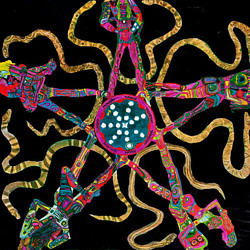 Mari Tepper: Laying it on the Line
Mari Tepper: Laying it on the Line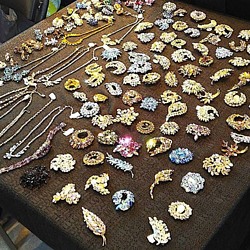 Nice Ice: Valerie Hammond on the Genteel Charm of Vintage Canadian Costume Jewelry
Nice Ice: Valerie Hammond on the Genteel Charm of Vintage Canadian Costume Jewelry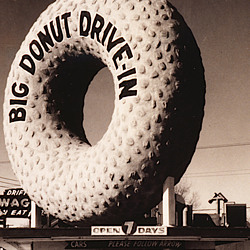 How Jim Heimann Got Crazy for California Architecture
How Jim Heimann Got Crazy for California Architecture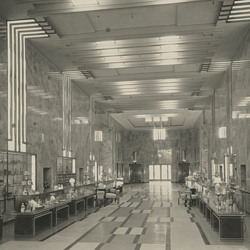 Modernist Man: Jock Peters May Be the Most Influential Architect You've Never Heard Of
Modernist Man: Jock Peters May Be the Most Influential Architect You've Never Heard Of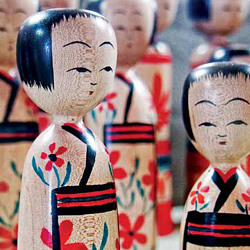 Meet Cute: Were Kokeshi Dolls the Models for Hello Kitty, Pokemon, and Be@rbrick?
Meet Cute: Were Kokeshi Dolls the Models for Hello Kitty, Pokemon, and Be@rbrick? When the King of Comedy Posters Set His Surreal Sights on the World of Rock 'n' Roll
When the King of Comedy Posters Set His Surreal Sights on the World of Rock 'n' Roll How One Artist Makes New Art From Old Coloring Books and Found Photos
How One Artist Makes New Art From Old Coloring Books and Found Photos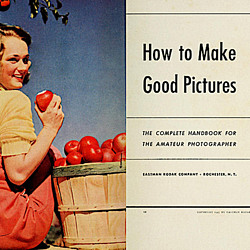 Say Cheese! How Bad Photography Has Changed Our Definition of Good Pictures
Say Cheese! How Bad Photography Has Changed Our Definition of Good Pictures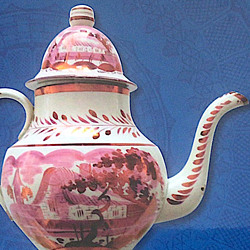 Middle Earthenware: One Family's Quest to Reclaim Its Place in British Pottery History
Middle Earthenware: One Family's Quest to Reclaim Its Place in British Pottery History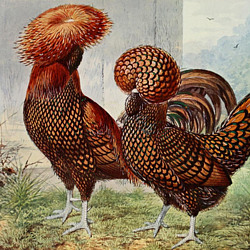 Fancy Fowl: How an Evil Sea Captain and a Beloved Queen Made the World Crave KFC
Fancy Fowl: How an Evil Sea Captain and a Beloved Queen Made the World Crave KFC
I have a blown glass drinking glass with silver flowers that has been put on it. It looks like a victornian peice. Any ideas.
I have a pair of ships- vessels, made od glass, blown glass, probably !9th century, any ideas where they could have information about them.